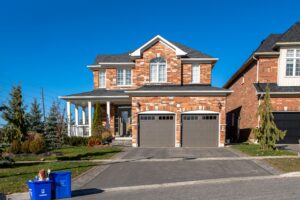What is structural damage and how does it happen?
Structural damage refers to any kind of harm or deterioration that affects the stability, strength, and durability of a building’s foundation, walls, roof or other essential structural components. Structural damage may occur due to several reasons like natural disasters such as earthquakes and floods, poor construction quality, aging building materials or pests like termites.
The severity of the structural damage depends on its cause and how long it has gone untreated. Common signs of structural damage include cracked walls or floors, uneven floors and ceilings, sagging roofs or leaning walls. In some cases, these damages can also lead to moisture problems such as mold growth.
While structural damage can be alarming for homeowners; don’t panic! In most cases with professional help you can fix it quickly depending on the extent of the problem. Professional contractors will first assess the extent of the problem before recommending a course of action which could include reinforcing your home’s foundations with new piers or beams in addition to replacing broken pillars if necessary.
Types of structural damage:
Structural damage to a house can be caused by various factors, including natural disasters like earthquakes, floods, and hurricanes. It can also result from poor workmanship during construction or wear and tear over time. Whatever the cause may be, it is crucial to identify the type of structural damage before deciding on the best course of action.
Some common types of structural damage include foundation cracks or settling, wall and roof cracks, uneven floors or sagging ceilings, and water damage. Foundation cracks can indicate a serious problem that requires immediate attention as they can lead to extensive damages if left unchecked. Wall and roof cracks may seem minor but should not be ignored as they could eventually compromise the integrity of the structure.
Fortunately, most types of structural damage are fixable with proper repair techniques such as foundation underpinning or stabilization systems. However, it is important to have a professional assessment done before proceeding with any repair work to ensure that all necessary repairs are made correctly so that further damages won’t occur in the future.
Causes of structural damage:
Structural damage is a common problem homeowners face, and it can be caused by a variety of factors. One of the main causes of structural damage is natural disasters such as earthquakes, floods, and hurricanes. These events can cause significant destruction to homes, resulting in cracked or shifted foundations, warped walls or ceilings, and other types of structural damage. Additionally, poor construction practices can also lead to structural issues over time.
Another major factor that contributes to structural damage is water damage. Water intrusion from leaking pipes or roofs can weaken the foundation and compromise the integrity of the structure. Moisture buildup can also lead to mold growth which further damages the property’s structure.
While some forms of structural damage may seem minor at first glance, it’s essential to address them promptly before they worsen. The good news is that most types of structural damage are repairable with proper assessment and effective repairs carried out by qualified professionals with experience in dealing with various forms of structural problems. In summary, whether caused by natural events or man-made errors like improper construction practices or water intrusion; timely intervention is key when dealing with any form of property-related issue if you want it fixed properly without leading to more complications down the road.
Treatment of structural damage:
Structural damage to a house can be a serious issue that requires immediate attention. The extent of the damage will determine the type of treatment required. In some cases, minor cracks or settling can be fixed relatively easily with simple repairs such as patching and painting. However, more severe damage such as foundation issues or structural instability may require more extensive measures.
One common method used to treat structural damage is underpinning. This involves strengthening the home’s foundation by installing additional supports beneath it. Another option is to use steel braces or beams to stabilize the structure and prevent further movement or collapse. In extreme cases, complete demolition and reconstruction may be necessary.
It is important to address any structural damage promptly in order to prevent further deterioration and potential safety hazards. A professional inspection is recommended in order to accurately assess the extent of the damage and determine the most appropriate treatment plan for your specific situation.
Conclusion
In conclusion, it is possible to fix structural damage to a house. However, the process and cost of repair will depend on the extent of the damage. It is important to hire a professional engineer or contractor to assess the level of damage and recommend appropriate repairs.
In some cases, minor cracks can be fixed with simple techniques such as filling in gaps with epoxy or injecting polyurethane foam into cracks. More extensive damage may require more complex repairs like installing additional support beams or replacing damaged foundation walls.
It is important for homeowners to address any structural issues promptly, as neglecting them can lead to further deterioration and potential safety hazards. With proper attention and care, a home can be restored to its original stability and strength.


